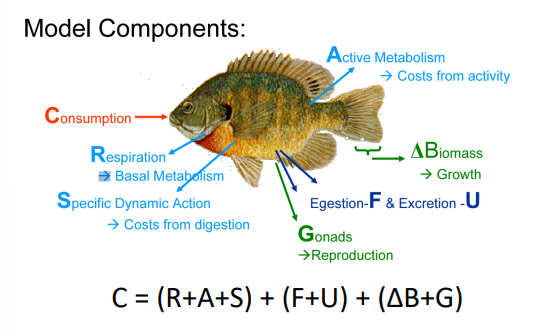Measuring and calculating nutrient utilization in cultured fish/shellfish
1/29
There's no tags or description
Looks like no tags are added yet.
Name | Mastery | Learn | Test | Matching | Spaced |
|---|
No study sessions yet.
30 Terms
What is nutrient utilization?
How efficiently fish absorb, digest, and metabolize nutrients from their diet to support growth, reproduction, immune function, and overall health
It involves the processes of ingestion, digestion, absorption, assimilation, and excretion of macronutrients (proteins, lipids, carbohydrates) and micronutrients (vitamins and minerals)
Key aspects of nutrients utilization in fish?
Protein utilization
Lipid utilization
Carbohydrate utilization
Energy utilization
Protein utilization?
Essential for muscle growth and enzyme production
Digestibility varies varies (animal vs plant based proteins)
Excess protein is deaminated, with nitrogen excreted as ammonia
Lipid utilization
Primary energy source; essential for cell membranes, hormone production, and immune function
Marine fish require essential fatty acids (EPA, DHA)
Lipid metabolism affects energy efficiency and growth rates
Carbohydrate utilization
Fish have limited ability to digest carbohydrates compared to terrestrial animals
Limited digestion in carnivorous fish; better in herbivores/omnivores
Excess leads to fat deposition in the liver
Energy utilization
Derived from protein and lipids
Energy balance affects feed conversion efficiency (FCR) and growth performance
Model Components

Feed conversion ratio

Feed efficiency

Dry matter (DM)
The portion of a sample that remains after removing all moisture
It includes proteins, lipids, carbohydrates, ash, and other nutrients
Unit = %

Moisture content
Represents the amount of water present in a sample
It is crucial in determining the shelf life and stability of fish and fish feed
Unit = %

Ash
Represents the total mineral (inorganic) portion left after a sample is burned at high temp (>500 degree Celsius)
It provides information about the mineral composition in fish or feed
Unit = %

Crude protein
Total protein content in a sample, estimated based on nitrogen content using the Kjedahl or Dumas method
Unit = %

Crude Lipid
The total fat content extracted from a sample using organic solvents like ether
Unit = %

Carbohydrate content
Estimated as the remaining portion of dry matter after subtracting protein, lipid, ash, and fiber
Unit = %

Gross energy
Represents the total energy content in a sample
calculated based on the caloric values of macronutrients
Unit = MJ/kg

Nutrient digestibility
Includes protein, lipid, and energy digestibility
Measured directly from differences between the feed intake and fecal output

Crude protein digestibility
The proportion of dietary protein that is digested and absorbed by the fish, rather than being excreted as feces
Key parameter in evaluating feed efficiency
Unit = %

Lipid digestibility
The proportion of dietary lipids (fats) that are digested and absorbed by the fish, rather than being excreted in the feces
It is an important measure of feed efficiency, particularly for evaluating fat utilization and its contribution to fish growth
Unit = %

Energy digestibility
The proportion of the energy from the feed that is absorbed and retained by the fish, as opposed to being lost in the feces
It is an important indicator of how effectively the fish convert the energy for growth, maintenance, and reproduction
Unit = %

Protein efficiency ratio (PER)
Measure of protein quality that evaluates how efficiently a given protein supports growth
Defined as the weight gain of an animal per unit of protein consumed
Commonly used in nutrition studies, especially in animal feed and food protein evaluation

Nutrient retention
The proportion of consumed nutrients that are retained in the fish’s body for growth, maintenance, and physiological functions, rather than being lost through excretion or metabolism
Protein retention
Lipid retention
Energy retention
Protein retention
The proportion of dietary protein consumed by the fish that is retained in its body for growth and tissue development, rather than being lost through excretion or metabolism
it is an essential measure of protein utilization efficiency in aquaculture
Unit = %

Lipid retention
The proportion of dietary lipids (fats) that are stored in the fish’s body for energy reserves and growth, rather than being metabolized or excreted
It is a key indicator of fat deposition efficiency
Unit = %

Energy retention
Measures how effectively the fish converts dietary energy into body energy for growth and maintenance
A higher energy retention percentage indicates better feed efficiency and utilization
Unit = %

Factors influencing nutrient utilization
Feed related factors
Fish related factors
Environmental factors
Feeding management
Feed related factors
Ingredient composition - highly digestible proteins (e.g fishmeal) improve absorption
Feed processing - extruded feeds with water stability enhance nutrient availability
Antinutritional factors - Tannins / phytates / protease inhibitors in plant-based feeds reduce protein digestibility
Feed additives - enzymes (e.g. phytase, protease) can enhance nutrient availability and absorption
Protein-to-energy ratio - imbalanced protein-energy ratios lead to excessive nitrogen excretion and lower retention
Fish-related factors
Species-specific digestive physiology - carnivores digest proteins better; herbivores process plant efficiently
Age and growth stage - Juveniles have higher feed efficiency
Metabolic rate - fish with high metabolic rates require more energy, affecting retention efficiency
Gut microbiota - beneficial bacteria in the gut aid complex nutrient breakdown, improving digestibility
Environmental factors
Water temperature: optimal ranges enhance enzymatic activity and digestion efficiency
Dissolved oxygen (DO) levels - higher DO improves metabolism
Water quality (pH, salinity, ammonia levels) - poor water conditions stress fish, reducing digestive efficiency
Stocking density - overcrowding increases competition and stress, affecting feed intake and utilization
Feeding management
Feeding frequency and ration size - overfeeding increases nutrient wastage, while underfeeding limits growth potential
Feeding method - proper feed distribution minimizes feed loss and ensures uniform nutrient intake